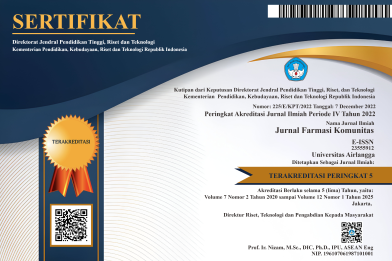Keyakinan dan Motivasi Remaja Putri di Surabaya untuk Melakukan Vaksinasi HPV
Downloads
Kanker serviks adalah penyakit menular seksual yang disebabkan oleh Human Papilloma Virus (HPV) . Kanker serviks berisiko tinggi tertular pada remaja berusia 15-16 tahun. Vaksinasi HPV dilakukan untuk pencegahan penyebaran kanker serviks. Penelitian ini menggunakan teori Health Belief Model (HBM) dengan tujuan untuk mengidentifikasi keyakinan dan motivasi remaja putri di Surabaya untuk melaksanakan vaksinasi HPV. Metode pengambilan sampel yang dilakukan adalah accidental sampling dengan 103 sampel remaja putri berusia 17-25 tahun yang berdomisili di Surabaya. Mayoritas responden berusia 20-22 tahun dengan riwayat tingkat pendidikan terakhir SMA dan sebanyak 98,1% berstatus belum menikah. Pada teori HBM, sebanyak 93,2% responden meyakini bahwa keparahan penyakit kanker serviks dapat menyebabkan kematian dan 87,3% responden berinisiatif melakukan vaksinasi HPV karena khawatir dengan akibat terkena kanker serviks. Adanya dukungan orang tua dan pemberian informasi terkait pelaksanaan vaksinasi HPV dapat mempengaruhi motivasi untuk melakukan vaksinasi. Hal ini menunjukkan bahwa upaya penyebaran informasi dan peningkatan keyakinan perlu dilakukan kepada remaja putri beserta keluarganya guna meningkatkan motivasi melakukan vaksinasi HPV.
Amador-Molina, A., Hernández-Valencia, J. F., Lamoyi, E., Contreras-Paredes, A., and Lizano, M. (2013) ‘Role of innate immunity against human papillomavirus (HPV) infections and effect of adjuvants in promoting specific immune response.', Viruses, 5(11),pp. 2624-2642. doi: 10.3390/v5112624.
Azwar, S. (2005) Sikap Manusia : Teori dan Pengukurannya. Yogyakarta: Pustaka Pelajar.
CDC (2021) HPV vaccine. Diakses pada tanggal 10 September 2022. https://www.cdc.gov/hpv/parents/vaccine-for-hpv.html
Depkes RI (2009) Buku saku pencegahan kanker leher rahim dan kanker payudara. Jakarta: Departemen Kesehatan RI .
Ekowati, D., Udiyono, A., Martini, M. and Adi, M.S. (2017) ‘Hubungan pengetahuan dengan persepsi mahasiswi dalam penerimaan vaksinasi HPV sebagai upaya pencegahan kanker serviks.', Jurnal Kesehatan Masyarakat, 5(4), pp. 334-341. doi: 10.14710/jkm.v5i4.18370
Elgzar, W. T., Alshahrani, M. A., Nahari, M. H., Al-Thubaity, D. D., Ibrahim, H. A., Sayed, S. H., and El Sayed, H. A. (2022) ‘Intention and self-efficacy for pap smear screening and human papilloma virus vaccination among Saudi women at Najran city, KSA.', African Journal of Reproductive Health, 26(7s),pp. 5-6. doi: 10.29063/ajrh2022/v26i7s.7.
Fitriani, Y., Mudigdo, A., and Andriani, R.B. (2018) 'Health belief model on the determinants of human papilloma virus vaccination in women of reproductive age in Surakarta , Central Java.', Journal of Health Promotion and Behavior, 3(1),pp. 16-26. doi: 10.26911/thejhpb.2018.03.01.02.
Rosenstock, I. M. (1974). The health belief model and preventive health behavior. Health education monographs, 2(4), 354-386. doi: 10.1177/109019817400200405
Johnson, C. A., James, D., Marzan, A., and Armaos, M. (2019) ‘Cervical cancer: an overview of pathophysiology and management.', In Seminars in oncology nursing. 35(2), pp. 166-174. doi: 10.1016/j.soncn.2019.02.003.
Kementerian Kesehatan RI. (2015) Keputusan Menteri Kesehatan RI No. 34 Tahun 2015 tentang Pedoman Teknis Pengendalian Kanker Payudara dan Kanker Leher Rahim. Jakarta: Kementerian Kesehatan Republik Indonesia
Lelly, E. (2020) ‘Faktor Risiko Kanker Serviks pada Wanita Lanjut Usia di RSD Gunung Jati Kota Cirebon.', Jurnal Health Sains, 1(1), pp.1-7. doi: 10.46799/jhs.v1i1.11.
Medlineplus (2022) Cervical cancer.Diakses pada tanggal 10 September 2022. https://medlineplus.gov/ency/article/000893.htm (online).
Misra, J. S., Srivastava, A. N., and Zaidi, Z. H. (2018) ‘Cervical cytopathological changes associated with onset of menopause.', Journal of Mid-life Health, 9(4), pp. 18. doi: 10.4103/jmh.JMH_4_18.
Nurlaila., Shoufiah, R., and Hazanah, S. (2016) 'Faktor-Faktor yang Berhubungan dengan Perilaku Melakukan Vaksin Kanker Serviks', Mahakam Midwifery Journal, 1(2), pp. 96-105.
Odafe, S., Torpey, K., Khamofu, H., Oladele, E., Adedokun, O., Chabikuli, O., Mukaddas, H., Usman, Y., Aiyenigba, B., and Okoye, M. (2013) ‘Integrating cervical cancer screening with HIV care in a district hospital in Abuja, Nigeria.', Nigerian medical journal : journal of the Nigeria Medical Association, 54(3),pp. 176–184. doi: 10.4103/0300-1652.114590.
Saslow, D., Castle, P.E., Cox, J.T., Davey, D.D., Einstein, M.H., Ferris, D.G., Goldie, S.J., Harper, D.M., Kinney, W., Moscicki, A.B. and Noller, K.L. (2007) ‘American Cancer Society Guideline for human papillomavirus (HPV) vaccine use to prevent cervical cancer and its precursors.', CA: a cancer journal for clinicians, 57(1), pp.7-28. doi: 10.3322/canjclin.57.1.7
Sung, H., Ferlay, J., Siegel, R. L., Laversanne, M., Soerjomataram, I., Jemal, A., and Bray, F. (2021) ‘Global Cancer Statistics 2020: GLOBOCAN Estimates of Incidence and Mortality Worldwide for 36 Cancers in 185 Countries.', CA: a cancer journal for clinicians, 71(3), pp. 209–249. doi: 10.3322/caac.21660
Taneja, N., Chawla, B., Awasthi, A. A., Shrivastav, K. D., Jaggi, V. K., and Janardhanan, R. (2021) ‘Knowledge, Attitude, and Practice on Cervical Cancer and Screening Among Women in India: A Review. Cancer control.', journal of the Moffitt Cancer Center, 28. doi: 10.1177/10732748211010799
WHO (2017) HPV Vaccine Communication 2016 Update. Diakses pada 28 Oktober 2022. https://www.who.int/publications-detail-redirect/WHO-IVB-16.02
Willows, K., Lennox, G., and Covens, A. (2016) ‘Fertility-sparing management in cervical cancer: balancing oncologic outcomes with reproductive success.' Gynecologic oncology research and practice, 3(9), pp. 1-14. doi: 10.1186/s40661-016-0030-9.
Xavier-Júnior, J. C., Vale, D. B., Zeferino, L. C., & Dufloth, R. M. (2015) ‘Association between concurrent genital bleeding and cervical cancer: a cross-sectional study.' Acta obstetricia et gynecologica Scandinavica, 94(9),pp. 949–953. doi: 10.1111/aogs.12682
Copyright (c) 2023 Jurnal Farmasi Komunitas

This work is licensed under a Creative Commons Attribution-NonCommercial-ShareAlike 4.0 International License.
In order to be accepted and published by JFK, author(s) submitting the article manuscript should complete all the review stages. By submitting the manuscript, the author(s) agreed to these following terms:
1. Copyright of the article is transferred to the journal (JFK), by the knowledge of the author, whilst the moral right of the publication belongs to the author. The intended copyright includes the rights to publish articles in various forms (including reprints). JFK maintain the publishing rights to the published articles.
2. The formal legal aspect of journal publication accessibility refers to the Creative Commons Attribution-Non-Commercial-Share Alike (CC BY-NC-SA), which implies that the publication can be used for non-commercial purposes in its original form.
3. Every publication (print/electronic) is open access for educational, research, and library purposes. In addition to the objectives mentioned above, the editorial board is not responsible for copyright infringement
The Copyright Transfer Agreement Form can be downloaded ON THIS FORM.

Jurnal Farmasi Komunitas (JFK) by Unair is licensed under a Creative Commons Attribution-NonCommercial-ShareAlike 4.0 International License.








